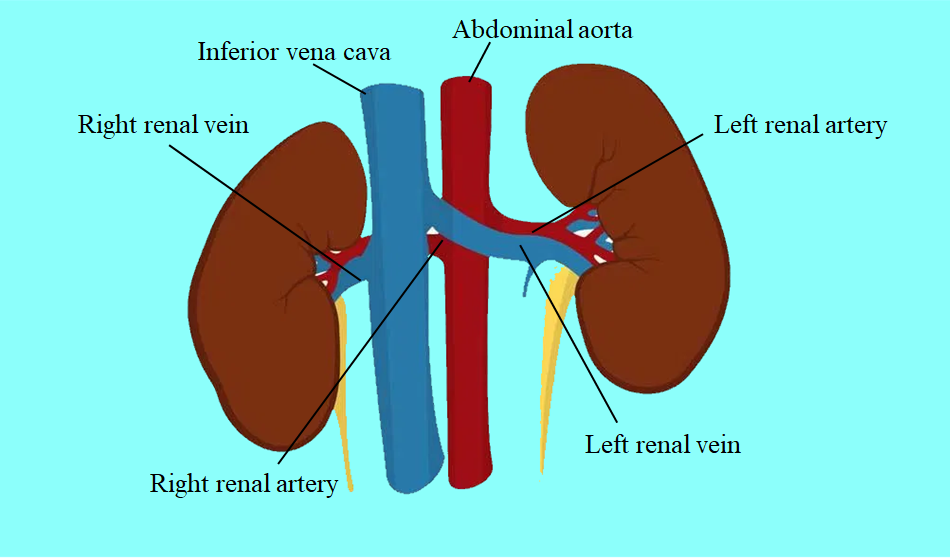
Oxygenated blood enters the kidney through the
(a)Hilus artery
(b)Renal portal system
(c)Renal arteries
(d)Renal vein
Answer
574.8k+ views
Hint: They normally arise off the left interior side of the abdominal aorta. They carry a high portion of total blood flow to the kidneys. Up to a third of total cardiac output can pass through it to be filtered by the kidneys.
Complete answer:
The renal artery is a short paired artery that arises from the lateral aspect of the aorta. Its location is in the retroperitoneum, where it courses laterally towards the hilum of the kidney. The renal artery emits several small branches before dividing it into its terminal anterior and posterior branches in the hilum of the kidney.
The function of the renal artery is two-fold; renal artery carries mineral-rich, oxygenated blood from the heart to the kidneys for nutrition and cellular respiration, and simultaneously delivers the blood to be purified by removing metabolic wastes and excess water and reabsorbing minerals and nutrients.
Additional Information:
The renal vein moves out of the kidneys and carries the blood back to the heart. Since the kidneys extract the nitrogenous metabolic wastes, the renal vein will therefore have the smallest amount of nitrogenous metabolic wastes. The hepatic artery and vein take blood into and out of the liver respectively.
The hepatic portal system collects blood from the intestine and passes it to the liver. The liver is the centre for many chemical reactions concerned with the absorption of food into the body and the control of substances entering the general circulation.
The renal hilum is the hilum of the kidney. It recessed central fissure where its vessels, nerves, and ureter pass. This fissure is a hilum, which transfers the vessels, nerves, and ureter. From anterior to posterior, the renal vein leaves, the renal artery enters, and the renal pelvis leaves the kidney.

So, the correct answer is ‘renal arteries’.
Note: The kidneys also regulate the production of oxygen-delivering red blood cells. When the kidneys don’t get enough oxygen, their signal comes within the form of production of erythropoietin, a hormone that stimulates the bone marrow to supply more oxygen-carrying red blood cells.
Complete answer:
The renal artery is a short paired artery that arises from the lateral aspect of the aorta. Its location is in the retroperitoneum, where it courses laterally towards the hilum of the kidney. The renal artery emits several small branches before dividing it into its terminal anterior and posterior branches in the hilum of the kidney.
The function of the renal artery is two-fold; renal artery carries mineral-rich, oxygenated blood from the heart to the kidneys for nutrition and cellular respiration, and simultaneously delivers the blood to be purified by removing metabolic wastes and excess water and reabsorbing minerals and nutrients.
Additional Information:
The renal vein moves out of the kidneys and carries the blood back to the heart. Since the kidneys extract the nitrogenous metabolic wastes, the renal vein will therefore have the smallest amount of nitrogenous metabolic wastes. The hepatic artery and vein take blood into and out of the liver respectively.
The hepatic portal system collects blood from the intestine and passes it to the liver. The liver is the centre for many chemical reactions concerned with the absorption of food into the body and the control of substances entering the general circulation.
The renal hilum is the hilum of the kidney. It recessed central fissure where its vessels, nerves, and ureter pass. This fissure is a hilum, which transfers the vessels, nerves, and ureter. From anterior to posterior, the renal vein leaves, the renal artery enters, and the renal pelvis leaves the kidney.

So, the correct answer is ‘renal arteries’.
Note: The kidneys also regulate the production of oxygen-delivering red blood cells. When the kidneys don’t get enough oxygen, their signal comes within the form of production of erythropoietin, a hormone that stimulates the bone marrow to supply more oxygen-carrying red blood cells.
Recently Updated Pages
Master Class 11 Social Science: Engaging Questions & Answers for Success

Master Class 11 Physics: Engaging Questions & Answers for Success

Master Class 11 Maths: Engaging Questions & Answers for Success

Master Class 11 Economics: Engaging Questions & Answers for Success

Master Class 11 Computer Science: Engaging Questions & Answers for Success

Master Class 11 Chemistry: Engaging Questions & Answers for Success

Trending doubts
What is meant by exothermic and endothermic reactions class 11 chemistry CBSE

10 examples of friction in our daily life

One Metric ton is equal to kg A 10000 B 1000 C 100 class 11 physics CBSE

Difference Between Prokaryotic Cells and Eukaryotic Cells

1 Quintal is equal to a 110 kg b 10 kg c 100kg d 1000 class 11 physics CBSE

Draw a diagram of nephron and explain its structur class 11 biology CBSE




